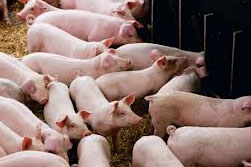Impact of multiphase feeding on pig preformance

The animal ‘Article of the Month’ for May, highlighted by Cambridge Journals is entitled “The impact of daily multiphase feeding on animal performance, body composition, nitrogen and phosphorus excretions, and feed costs in growing–finishing pigs”, the paper discusses an important step in the development of precision livestock farming systems.
Pigs are monogastric animals which are fed in many countries with high-quality diets and in industrial or semi-industrial pork production systems; feed costs represent then more than 60% of the overall production cost. Growing and finishing pigs are housed in large size groups/barns and receive the same feed during long feeding periods, even if growth potential and therefore nutrient requirements change overtime. Feeding strategies and feed composition have important effects on animals’ performance and manure composition. Non-retained dietary nutrients are excreted and they represent important economic losses while, in some cases as with nitrogen and phosphorus, they may contribute to increase the environmental impact of pork production systems. Many large pork-producing countries are facing the dilemma of balancing the economic viability of the pork industry with the sustainability of the overall agricultural environment.
Theoretically, it is possible to feed pigs with daily feeds formulated to satisfy each day population requirements. These daily feeds will undoubtedly minimise feed ingredient costs and nutrient excretions, but for technical reasons (transport, feed storage), this feeding method is not actually viable. Blend feeding and the automatic distribution of two feeds that, combined in variable ratios, could meet the requirements of pigs throughout the growing period, is a promising feeding technique because it allows for significant reductions in nutrient excretion without increasing feeding costs. Blend feeding may also be a promising option for feed manufacturers, because only two feeds need to be prepared, transported and stored, with only the proportion of the blend changing over time.
However, because the needs for the various nutrients do not evolve in the same manner during growth, the preparation of these feeds becomes a non-linear problem that requires more complex resolution algorithms. Mathematical programming was used in this study to formulate optimal feeds and successfully used to implement a daily-phase feeding system for pigs housed in groups. For example, this paper reports that feeding growing-finishing pigs with the proposed daily multiphase feeding system can reduce without affecting growth, feed costs by 1.0%, nitrogen intake by 7.3% and its excretion by 12% in comparison with a traditional three-phase feeding systems. Daily multiphase feeding can also help reducing phosphorus intake and excretion.
The simultaneous formulation of the two feeds required for blend feeding and the concomitant adjustment of the dietary concentration of nutrients to match the evolving requirements of pig populations can be an efficient approach to significantly reduce feeding cost and nitrogen and phosphorus excretion in pig production systems. This approach can also be used in gestating and lactating sows as well as in other farmed animals (poultry, dairy cattle, beef, etc.). Other formulation methods are also under study and preliminary results indicates that when the two feeds are formulated simultaneously at variable energy density and without the requirement of being complete, feed costs can be reduced by 5.8%.
Furthermore, feeding pigs individually rather than in group with diets tailored daily to individual requirements is also under study. This precision feeding alternative may further contribute to reduce feed costs and improve the efficiency by which nutrients are used by growing animals. Preliminary results indicate that individual tailored feeding can require 25% less nutrients (protein, lysine, etc.) than actual feeding systems while their excretion can be reduced by near 50%. In this situation, feed costs are expected to be reduced by more than 10%.
Authors: C. Pomar, J. Pomar, F. Dubeau, E. Joannopoulos and J.-P. Dussault
Source: Cambridge Journal Blog











